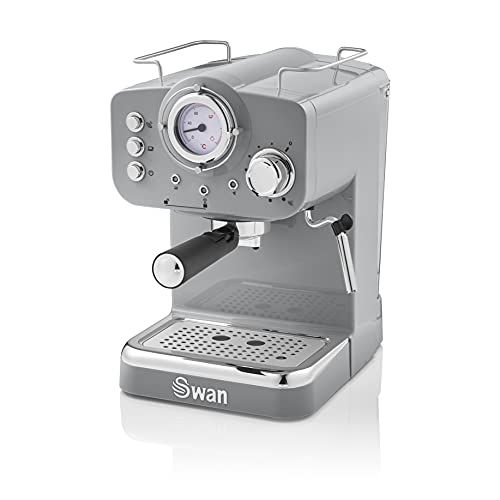What to Look For in a Commercial Espresso Machine
When you are looking to purchase a commercial coffee machine, there are many things to take into consideration. The type of espresso machine right for your cafe will depend on the volume, the intended use, and barista's skills.
A double boiler system provides the capability of brewing and steam simultaneously. This cuts down on the time to recuperate between pulls. Proportional-integral-derivative (PID) temperature control manages on/off cycles for optimal boiler temperatures.

espresso coffee maker can handle a larger amount of coffee than a home machine. A domestic espresso machine would not be able to perform in a professional setting.
A commercial coffee machine of good quality can provide up to 100 cups of coffee every hour during peak hours. This can be an enormous help in busy workplaces, since it prevents employees from waiting around to get their coffee.
A coffee machine can also help workers connect. Oftentimes teams of people will make a habit of getting coffee for each other which can promote collaboration and teamwork in the workplace. A coffee bar can make new employees feel more at ease at work and help break down barriers between them, the senior staff members, and other workers.
Commercial espresso machines are available in several sizes to meet a variety of needs. Some models are fully automated, while others can pre-program espresso shot sizes so that the operators do not have to guess at the right size. This is especially important for businesses that have untrained baristas since incorrect shots can alter the intensity and taste of espresso. It is also advisable to purchase commercial espresso machines made from ethically sourced products that benefit the communities where coffee beans are harvested. This will ensure a premium quality product and reduce the negative impact on the environment.
Safety
Espresso machines are massive machines that weigh a lot that can cost more than a brand new compact car. They're also designed to pump out a multitude of drinks and shots throughout the course of a day. These high-volume operations can cause unique safety and health risks for employees, which is why it's crucial to think about the potential risks that come with the commercial espresso machine.
It is important to keep in mind that commercial espresso machines are likely to run on warm water, which could cause the development of bacteria. If a machine is not properly maintained and isn't descaled or cleaned regularly can begin to accumulate spent espresso, which could become rancid and cause illnesses if consumed by customers. A commercial espresso machine that has a steam wand without a seal that is effective could allow for bacterial growth in the milk frothing mechanism, as it may not be able to reach temperatures that are sufficient to kill all bacteria.
When selecting a commercial espresso machine it is important to think about the type of beverages you'll be serving and the number of cups per hour your space can hold. You'll also want an espresso machine with automation features that make it simpler and quicker to serve your patrons their favorite coffee drink. In addition, look for a guarantee that covers parts and labor so that any technical issues are solved quickly and efficiently.
Energy Efficiency
Commercial espresso machines require substantially more power than the home models. Professional espresso machines are heavier and come with larger boilers to support several group heads for regular cafe production. They also operate at a much greater temperature at ambient temperatures and are typically in an indoor setting (such as the cafe or restaurant) where the electronics may overheat quickly, resulting in the machine breaking down.
The boiler of an espresso machine for commercial use heats up and holds water that is pressurized by an electric pump. This water is then used to brew and steaming espresso. The boiler is comprised of a number of copper tubes that are heated by electric elements. If the brew sensor detects that the water level is at the desired level the solenoid valve will open and the boiler is filled with new water. The heating element is then turned off.
There are four variations of espresso machines that are distinguished by their ability to brew and steam: the TB (brewing only), TX (twin boilers) HX, TB, and DA (double automatic). TB and TX machines provide stable brew temperatures, whereas DA provides rapid steaming with one boiler. Many cafes are converting to HX machines as they have been proven to offer the best of both worlds, in terms of the temperature of steam and brew.
Maintenance
Like cars that require regular tune-ups commercial espresso machines require maintenance to continue working smoothly and efficiently. If you make the effort to keep your machine in top condition, it will give you a more delicious coffee and last longer.
Cleaning your espresso machine is a regular practice, but it's crucial to clean certain components on a deeper level. There's going to be residue from coffee grounds and milk products inside the machine, which can degrade various components over time. Regular cleaning can prevent this from happening and helps keep your espresso machine operating at the best it can.
Most commercial espresso machines require descaling at least every 3 months. This process requires a few more steps over regular cleaning, so you'll want check your manual regularly to ensure that you're adhering to the directions. The solution used to clean the water tank dissolves the scale. You'll need a tank to finish this task. In some models, you may also need an additional container under the coffee spouts. Follow the instructions on your model.
Another aspect of maintenance is changing the water filters. This is something that can easily be overlooked, but it's important to keep in mind so you don't end up with a build-up of mineral deposits. You'll also want to check for calcification within the spray head, which can be difficult to get rid of.
